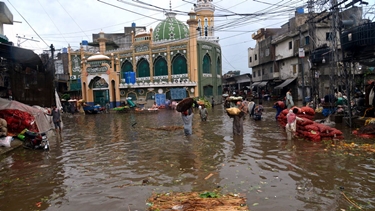With climate change set to exacerbate the frequency and severity of disaster events, Central Asia and South Asia face a growing risk protection gap.
KEY TAKEAWAYS
- With climate change set to exacerbate the frequency and severity of natural hazards, Central Asia and South Asia face higher risk to lives and livelihoods.
- Pre-arranged disaster risk financing can help countries respond more effectively in the immediate aftermath of disasters such as floods or earthquakes.
- Governments are setting up financial protection measures against disasters, but not all countries have enough disaster risk financing.
Last year’s devastating floods in Pakistan affected around 33 million people and caused an estimated $30 billion in damage. This year, the country was rocked again by a 6.5 magnitude earthquake which also affected neighboring Afghanistan and five Central Asian republics. And just this month, blazing forest fires destroyed up to 60,000 hectares of land in northeastern Kazakhstan, killing 14 people.
These events are a tragic reminder that Central Asia and its neighbors are highly exposed to natural hazards such as flooding and earthquakes. With climate change set to exacerbate the frequency and severity of such events, the region faces a growing risk protection gap.
That financing gap is quantified in Narrowing the Disaster Risk Protection Gap in Central Asia, a report from the Asian Development Bank (ADB). ADB Principal Finance Specialist for Disaster Insurance Thomas Kessler explains how countries in Central Asia can work together to close this funding gap.
Why is disaster risk protection important in Central Asia?
Resilience against disasters caused by natural hazards is critically important in parts of Asia and the Pacific that are prone to earthquakes and climate risk. Countries can reduce their exposure by building flood defenses, retrofitting infrastructure, and setting up evacuation and response plans. These steps protect lives, livelihoods, and economies. But even with well-planned and executed measures, there will always be some level of risk.
In the Central Asia Regional Economic Cooperation (CAREC) Program region—which includes Central Asia, parts of South Asia and South Caucasus, Mongolia, and the People’s Republic of China—rapid economic development also means the value of assets at risk from disasters has risen.
According to our report, floods and earthquakes cause average annual losses of about $4.7 billion in the region. This is the long-term expected losses per year from disaster events, averaging out more frequent but less severe events, with events that may happen less often but can be more damaging.
While governments are setting up financial protection measures against disasters, not all CAREC members have enough liquid disaster risk financing available to respond quickly and effectively after a damaging event.
Why set up financing mechanisms ahead of a disaster?
When disasters hit, financing usually comes after the event in unplanned borrowing, budget reallocations, and humanitarian support. This works for countries with ample fiscal space that can quickly access financing. But governments with limited spending power tend to rely on humanitarian support, which is vital, but can vary in terms of amounts, speed, and reliability.
Some financing can be arranged before a disaster occurs. The pre-arranged finance, known as ex ante disaster risk financing, can be a critical source of funding to repair damaged infrastructure and kick-start the economy. Such financing fits into one of two categories: risk transfer or risk retention. So called risk transfer strategies, include instruments such as insurance and disaster relief bonds. They shift potential losses to external parties such as insurance companies or bond investors which are paid a premium for taking on that risk. Risk retention strategies are where the government sets up a reserve fund for losses associated with adverse events, including through savings, and contingent disaster financing loans.
Risk transfer and risk retention are not mutually exclusive. Given the wide variety of potential risks from natural hazards in terms of frequency and severity, countries need a mix of financing instruments to fund their overall disaster protection strategy. Risk retention strategies alone may not be able to cover particularly large or unexpected disasters.
In which scenarios can these financial instruments be used?
Risk retention measures are suitable for covering the losses associated with frequent but low intensity events. Flash flooding, for example, can occur every few years due to intense rain. The frequency of such events means it is not viable for governments to transfer this risk to third parties, while the cost of damage generally won’t hamper government spending priorities.
However, risks associated with rare but severe catastrophes are typically better protected through risk transfers. Losses expected from a devastating earthquake or national-scale flooding, for example, could more efficiently be covered by risk transfer mechanisms. For the most extreme events, especially in larger countries, affordable insurance capacity from insurance, reinsurance and capital markets may be limited. Here post-event donor assistance will play a role.
What challenges does the region face in closing the “protection gap”?
For example, low sovereign credit ratings in countries like Pakistan and Tajikistan make it more expensive for these governments to borrow from private capital markets. This is compounded by the fact that some provinces, where risk and vulnerability coincide most strongly in these countries, are characterized by a heavy reliance on agriculture and basic agro-processing, which is largely done by small farms and businesses.
The Kyrgyz Republic and Uzbekistan do have some form of risk retention mechanisms in place, but risk and vulnerability are high in areas where agriculture and manufacturing activities are also important.
Azerbaijan, Georgia, and Kazakhstan also already have risk retention measures that can cover losses from floods, earthquakes and emergency response needs. But direct losses could exhaust these resources, prompting the need for risk transfer instruments to support reconstruction costs.
Can regional cooperation play a role?
Yes. With member countries facing common disaster-related risks, setting up a regional risk transfer mechanism could narrow the protection gap in a cost-efficient way. For instance, countries can collaborate to purchase insurance collectively. This would diversify the levels of risk among the different countries and allow them to share fixed and administrative costs—hence lowering overall costs.
Regional cooperation also allows countries to share best practice on how to prepare and manage disaster risk.
The sustainability of a regional facility would depend on three factors.
First, the risk financing should meet the needs of all member countries to ensure their commitment.
Second, the risks covered by the protection plans should be well-balanced so that the cost of the risks covered in any one country won’t exhaust the resources required to cover the risks of another country. This should also minimize the need for reinsurance to protect the funds of a regional facility and guarantee its claims paying ability.
Third, countries should be incentivized to put in place climate mitigation and adaptation efforts to limit the rising costs of protection and improve the resilience of their economies and people to disaster events. ///ADB, 27 June 2023
#ADB, #Central_Asia, #climate_change, #disaster_risk _protection, #Azerbaijan, #China, #Georgia, #Kazakhstan, #Kyrgyzstan, #Mongolia, #Pakistan, #Tajikistan, #Turkmenistan, #Uzbekistan, #Environment, #Disaster_Risk_Management, #Regional_cooperation_integration

